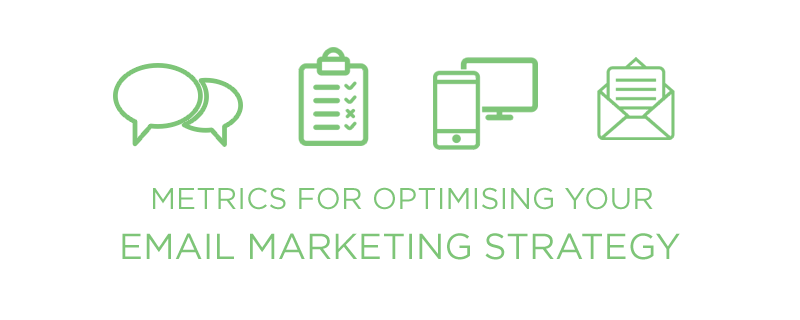BLOG
4 Email Marketing Metrics you need to Track
Your email marketing strategy is the foundation of your digital marketing campaign. No other type of marketing allows you to target so many consumers at once in a variety of different ways, but even though you have so much ability in email marketing, how do you know that your efforts are doing any good for your company?
Tracking certain marketing metrics can tell you all you ever needed to know about how well your email marketing strategy is working. From open rates to click-through rates, you can gauge the success of your email strategy over time and make vital improvements that will help you do better in the future.
Want to learn the secrets to a great email marketing strategy? Here are the four most important email marketing metrics you need to track to be successful.

Long-term engagement
You know that the time and date that you send out emails can have a big impact on whether or not your emails are opened and read. Each demographic checks their email at different times of the day, and if you send emails out too early in the day, other emails will pile on top of it, lessening your chances of being opened. If you send emails too late in the day, readers might not see the email until the next day, at which point other emails have once again buried yours.
While many digital marketers will swear that one certain time of day is best for all demographics, the truth is you won’t really know unless you monitor it. By monitoring long-term engagement and varying the times you send your emails, you can look for patterns and determine when your readers are more likely to open up your emails.
You might find that your previous assumptions about when your readers check their emails are entirely wrong. Keep checking long-term engagement to see which times seem to be best for readers as this might change overtime.

Unsubscribe rate
Most digital marketers ignore their unsubscribe rates unless they’re unusually high, and they tend to look at these rates in a negative light. Sure, it does mean that you’re losing subscribers, but you can win more if you learn from what your unsubscribe rate is telling you.
Monitoring your unsubscribe rate can help you get the right content to the right audience. If you’re experimenting with different segments of your subscribers, your unsubscribe rate will help you gauge whether or not you’re on the right path.
For example, let’s say you’re working to define a certain demographic among your subscribers. You narrow down your emailing list and start sending out targeted content to those subscribers. Over the course of a few weeks, you see your unsubscribe rate go up a bit, and when you cross-reference who unsubscribed, you find that most of the unsubscribers were on that new emailing list you created. Therefore, your tactic wasn’t working and you can try something new.
It’s never fun to fail, but monitoring your unsubscribe rate and testing it against new email marketing endeavours can help you grow and discover new segments and demographics within your email subscriber list.

Most common device
In April 2015, Google launched a new update to its algorithm that placed a huge emphasis on responsive website design for mobile devices. Because mobile internet usage has skyrocketed, Google is now pushing down websites that are not responsively designed.
While this doesn’t really affected your email strategy, it should get you thinking about how readers are accessing your emails and whether they are designed to be responsive. Are they at their home computers like marketers have previously assumed, or are they out and about and accessing emails on their phones or tablets? Depending on how your subscribers are accessing your emails can help you decide how you should structure your emails.
Knowing which devices your audience uses the most will help you design the best emails to fit their device. Remember that mobile users and desktop users do not have the same screen size or the same ability to scroll. A short email on a desktop looks twice as long on a mobile device, and your audience might not have the time or the patience to scroll through the whole email.
The type of device can also affect reading times, which we discussed in the first section. Commuters on a train have access to the internet on their phones so they might be able to read your emails first thing in the morning.
Just knowing how your audience is reading your emails can tell you so much about them and how best to reach them. Like all other metrics, this may change over time so keep a close eye on it.

Open Email Times
How long does it usually take you to read the emails you create? Your open rate depends on the type of email you’re sending out. An email with a discount doesn’t need to be long, but a newsletter from your company will probably take a few minutes to read.
Now how can you be sure that your readers have the necessary time to read your emails? You can. With the time spent viewing metric, you can see how long your different emails were open for, which can tell you a lot about your readership.
Consider this: you send out two emails – one with a discount, the other a newsletter – to the same segment of your subscriber list. Most readers don’t spend much time with the discount email; they opened it, clicked through and got the discount. With the newsletter though, you notice that readers spent about the same amount of time with the email as the discount one. What does this tell you about your readership?
Clearly your audience is busy, and they’re not devoting a lot of time to reading your emails. That’s okay. The goal is not to make them stay longer. Your goal should be to accommodate your copy length to their schedules. If shorter emails get more reads and click throughs, then you should tailor your content to fill that need and improve your chances of getting your emails read.
Remember, no amount of email marketing is worth it if you don’t know what your readers like. Using these four metrics will help you gauge what your readers prefer, which will help you create better emails that will have the best chances of being opened.
What other metrics do you think are most helpful? Share your thoughts with us!











